6ª edición: 5, 6 y 7 de diciembre 2014 | English

![]() JAPAN MEDIA ARTS
JAPAN MEDIA ARTS
![]() FESTIVAL
FESTIVAL
![]()
![]() ARS ELECTRONICA
ARS ELECTRONICA
![]()
![]() ART FUTURA
ART FUTURA
![]()
![]() MUNDOS DIGITALES
MUNDOS DIGITALES
![]()
![]() GAME On! Videojuegos
GAME On! Videojuegos
![]()
![]() El MUR. Berlín
El MUR. Berlín
![]()
![]() VIDEOAKT
VIDEOAKT
![]()
![]() FIA. Uruguay
FIA. Uruguay
![]()
![]() MEDIA DOME.
MEDIA DOME.
![]() Serious Game
Serious Game
![]()
![]() DIGITAL LANDSCAPE
DIGITAL LANDSCAPE
![]() & Programa Curators
& Programa Curators
![]() - NEW YORK
- NEW YORK
![]()
![]() - ARGENTINA
- ARGENTINA
![]()
![]() MADE IN CANARIAS
MADE IN CANARIAS
![]()
![]() IMAGEN DIGITAL
IMAGEN DIGITAL
![]() Videoarte
Videoarte
![]() Videodanza
Videodanza
![]() Cortometraje/Largo/3D
Cortometraje/Largo/3D
![]() Web Film
Web Film
![]() Animación
Animación
![]()
![]() Arte Ciencia Innovación
Arte Ciencia Innovación
![]() Artificial life
Artificial life
![]() Software art
Software art
![]() Trangenic art
Trangenic art
![]() Generative art
Generative art
![]() Bioart
Bioart
![]() Nanotecnología
Nanotecnología
![]() Geospatial storytelling
Geospatial storytelling
![]() Videojuegos
Videojuegos
![]() Robótica
Robótica
![]() Free Software
Free Software
![]() 2D & 3D Animación
2D & 3D Animación
![]() Net-art
Net-art
![]() Comunidades Digitales
Comunidades Digitales
![]() Redes Sociales
Redes Sociales
![]() Blog, videoblog
Blog, videoblog
![]() Desarrollo Apps
Desarrollo Apps
![]() Creación plataformas
Creación plataformas
![]() móviles
móviles
![]() Data Visualization
Data Visualization
![]() Mapping
Mapping
![]() Telesharing actions
Telesharing actions
![]() Telepresencia
Telepresencia
![]()
![]() ¿quiénes somos?
¿quiénes somos?
![]()
![]() patrocinadores y
patrocinadores y
![]() colaboradores
colaboradores
![]()
![]() programa
programa
![]()
![]() fotos de la sede
fotos de la sede
![]()
![]()
![]()
![]() evento 2009
evento 2009
![]()
![]() evento 2010
evento 2010
![]()
![]() evento 2011
evento 2011
![]()
![]() evento 2012
evento 2012
![]()
![]() evento 2013
evento 2013
![]()
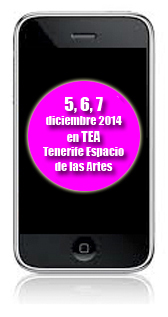
- Artificial Life
- Software art
- Transgenic art
- Generative art
- Bioart
- Nanotecnología
- Geospatial storytelling
- Videojuegos
- Robótica
- Free Software
- 2D & 3D Animación
- Net-art
- Comunidades Digitales
- Redes sociales
- Blog, videoblog
- Desarrollo Apps
- Creación plataformas móviles - Data Visualization
- Mapping
- Telesharing actions
- Telepresencia
![]()
Convocatoria Internacional 2014
![]()
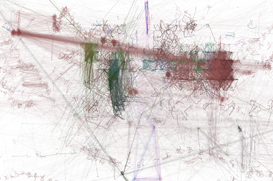
Benjamin Grosser
Urbana, IL. USA
http://bengrosser.com
http://vimeo.com/grosser
http://bengrosser.com/projects/computers-watching-movies/
https://vimeo.com/78711521
Proyecto: Computers Watching Movies
Computers Watching Movies shows what a computational
system sees when it watches the same films that we do.
The work illustrates this vision as a series of temporal
sketches synchronized with audio from the original clip.
Viewers are provoked to ask how computer vision differs
from their own vision, and what that difference reveals about our
culturally-developed ways of looking. Why do we watch what we
watch when we watch it? Will a system without our
sense of narrative watch the same things?
Computers Watching Movies was computationally produced using
software written by the artist. This software uses computer vision
algorithms and artificial intelligence routines to give the system some
degree of agency, allowing it to decide what it watches and what it
does not.
Six well-known clips from popular films are used in the work—
the scenes are from the following movies: 2001: A Space Odyssey,
American Beauty, Inception, Taxi Driver, The Matrix, and Annie Hall.
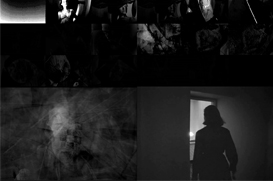
Hong Kong
http://concept-script.com/works.html
Proyecto: Theorem 8
Theorem 8 is made using a custom software designed by the artist,
which decomposes every frame in a movie using a fixed database
of frames from another movie. Using a mathematical tehcnique
known as orthogonal decomposition, it achieves a superposition
of frames from two different films.
The two films chosen are Godard’s Alphaville and Witch’s Cradle,
directed by Maya Deren in collaboration with Marcel Duchamp.
The two films were selected because their filmmakers used
light and shadow as dramatic elements. Godard can be seen a
response to the rise of cybernetics and information technologies.
Deren and Duchamp were interested in abstract mathematical
spaces. The title, Theorem 8, refers to the orthogonal decomposition
theorem, which concerns the idea of an object in a higher-dimensional
space projecting shadows onto a lower dimensional space.
The technique of orthogonal decomposition is often used in
surveillance software, and so the work aims to foreground, deconstruct, and liberate the computational aspects of surveillance technologies.Its underlying philosophy is that radical politics demands radical artistic forms.
tag: softwareart
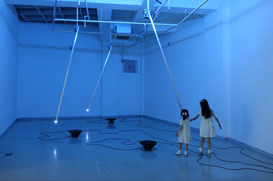
Seúl. Corea
www.hyunjeanlee.com
http://vimeo.com/100992347
Proyecto: The Breathe of the Sea
The sound installation work < The Breath of the Sea > is initiated with my
experience that I had encountered long time ago. That is one that I
happened to look at the situation of microphone which is connected its
end to a portable speaker for outdoor events was kept in moving
back and forth from the speaker on the long line like as a pendulum
movement. While looking at this situation, I could also hear that a noise
between the input(microphone) and output(speaker) of closed feedback
system created from this movement. And I thought immediately that it
sounds like sounds of the wave movement in the sea. After this experience,
for a while, I have conceived how to create the scene that the only sounds
of the sea waves are fulfilling the empty space. If it were visualized, there
is a speaker on the room floor and the microphone hanged under the
ceiling moving like a pendulum.
This work is the embodiment of this imagination and it conveys the
concept that how electrical and electronical feedback can be matched
and linked to the feedback in the nature (I think the wave movement is
the interaction between wind and water, as well as one of the feedback
between the tides such as ebb and flood). The machinery pendulum
repeats its motor movement between left and right. Depending on the
movement of each pendulum, the current state of each one’s interval
time(speed), directional change and locative position (left, right & in the
middle position or each ends of the pendulum’s arc orbit) of the
pendulum are delivered to the computer running Max/MSP via Arduino
creating a pure machine-generating pink noise. However this noise can
create the very sound of ocean wave movement sound. The machine-
making
sound are transformed to the very sound in the nature in front of our ears.
The wave sounds are repeated. It is newly and continuously generated and
come, and shattered and left again.
Fulfilling the sound of wave in the empty gallery space, this work suggests
the audience to think of how the breath of the machine can take after the
breath of the nature.
technicaldates: This work is across the following categories: the Software art, Generative art, Robotic, Data Visualization & Mapping, and sound
installation. 3 sets of pendulum set. Each set is controlled via Arduino, and the
actuator is a AC motor and each pendulum has a Super bright LED on its end of pendulum bar.
tag: softwareart
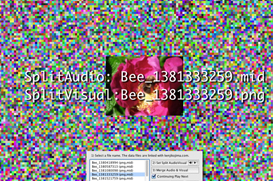
New York. USA
http://kenjikojima.com
https://vimeo.com/75856031
http://kenjikojima.com/splitMerge/
Proyecto: Split/Merge AudioVisual
When 20 century artists met a binary, they tried to use it as one of the art materials like earth colors of cave artists. Software art "Split/Merge AudioVisual" is experimenting with the boundaries or overlapped areas of different senses. The software splits a photograph to a music and an image files, then merges them into the original image.
Split(making project documents): Image pixels of a photograph are converted to 8-bits binary data. They are executed by a bitwise XOR operation using 8-bits binary of random numbers (from 0 to 255). This is a type of encryption scheme, called one-time pad. The result of encrypted image will be random color pixels. The random numbers are converted to musical notes. The number 120 is the middle C, and each two step numbers increase or decrease a half tone. The note length is determined by the number value. The color pixels are saved as a ping image file, and random numbers are a midi music file.
Merge(performance by the project software): The midi music is used as a decryption key on the color pixels of the ping file. The program collects musical notes from a midi file and converts them to binary. The binary of notes as a key executes on the binary of encrypted pixel color image by bitwise XOR. The project software performs processes of merging audio and visual on a full screen.
tag: softwareart

Buenos Aires. Argentina
likegohome.tomasrawski.com.ar
https://www.facebook.com/pages/Like-go-home/1467697393460827
Proyecto: Like go home
This extension for Chrome removes the button "Like" on Facebook. Communicate with text!
tag: softwareart
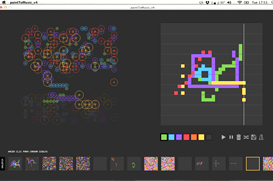
Valencia. España
http://carolinavallejo.x10.mx/
http://vimeo.com/cavalmar
https://www.flickr.com/photos/radio_draws
Proyecto: Pixel to music
Pixel to music parte de un proyecto investigación en interfaces de usuario lúdicas que permitan al usuario tener una doble experiecia creativa. El usuario se relaciona con la interfaz dibujando y de esta experiencia devienen composiciones sonoras.
Esta aplicación permite despreocuparse por componer "formalmente" el sonido, al poder componerlo a través de lo gráfico. En la interfaz los colores representan diferentes tipos de sonido, y con los colores es posible crear partituras gráficas que se pueden guardar en una galería y cargarlas para escucharlas de nuevo.
El proceso de composición sonora y gráfica se da al mismo tiempo, el usuario al mismo tiempo escucha, visualiza y manipula el resultado de la composición.
Para el uso de esta aplicación el usuario descubrirá que existe una zona de dibujo (semejante a un programa básico de dibujo por ordenador) donde puede dibujar pixeles de colores, inmediatamente podrá escuchar la traducción sonora y al mismo tiempo ver una visualización gráfica del sonido. Todo esto genera una dinámica donde el usurio toma desiciones para manipular lo gráfico que repercute en lo sonoro.
datostecnicos:Pixel to music es un juego gráfico-sonoro desarrollado como una aplicación para ordenador que rueda en sistema Mac OSX.
Para su exposición se proyecta la imagen con un proyector sobre la pared, para la salida de audio se pueden utilizan auriculares o altavoces (según sea el caso) y en un pedestal, que irá frente a la proyección, debe ir un ratón con el cual se podrá interactuar con la aplicación, no es necesario el uso de un teclado.
También es posible exponer la aplicación en un ordenador con pantalla y ratón.
tag: softwareart
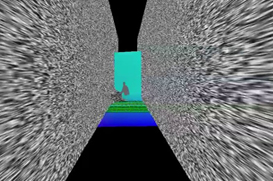
Londres. UK
www.mariosathanasiou.com
https://vimeo.com/100024312
Proyecto: Potential Entity
On the surface the flow of information in Nature appears to be chaotic and un-programmable. By adding layers of Virtual Nature this flow of information can be streamlined, manipulated and shaped according to ones needs. Fantasies become a corporeal reality. Potential Entity explores the expansion of human consciousness into the sphere of virtual reality. The participant is invited to enter into a 3D environment where materiality can be manipulated and distorted into a programmable flow of information.
The event took place at Telstra International, a disused data storage and telecommunications centre. The virtual side of the installation was streamed at www.potentialentity.com
tag: softwareart
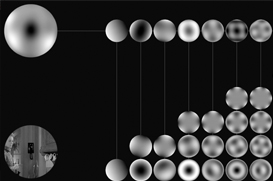
Hong Kong
http://concept-script.com/index.html
http://vimeo.com/100983326#at=0
Proyecto: Z
Z is a moving image analysis system that produces abstract representations of cinematic sequences using a system of predefined grayscale disks, thus facilitating the critical understanding and aesthetic appreciation of cinematic rhythm.
The system uses a mathematical framework that decomposes each movie frame (image function) by projecting it onto a set of orthogonal polynomials called the Zernike Polynomials.
An important inspiration for this project is Soviet filmmaker S. M. Eisenstein, who compared cinema with music. An image is for him the total sum of many visual stimulants, which are like the partials of a musical tone. The cinematic experience is in his view organized as a complex dynamic process of changing visual overtones. Z supplies a mathematical formalization of Eisenstein's idea, expressing it in an intuitive visual form. The system decomposes an image into its local harmonics, thus facilitating the critical analysis and aesthetic appreciation of cinematic rhythm.
tag: softwareart


